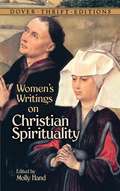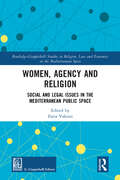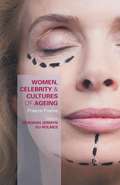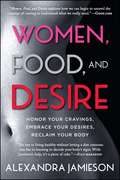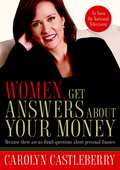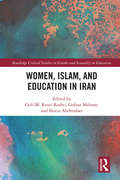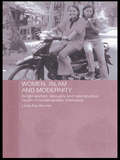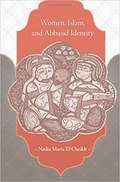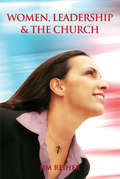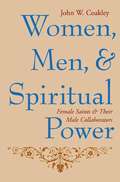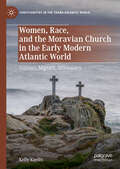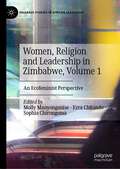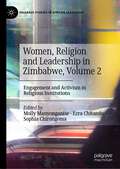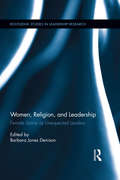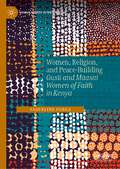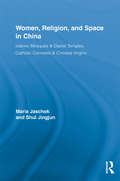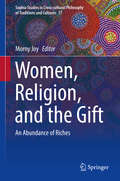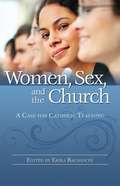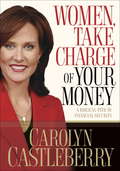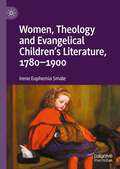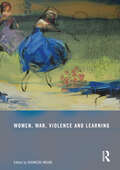- Table View
- List View
Women's Writings on Christian Spirituality (Dover Thrift Editions)
by Molly HandOrganized chronologically, this original anthology presents selections from women writers in the Christian tradition on the themes of religion and spirituality, ranging from the medieval (until 1500) and early modern (1500-1800) periods to the present. A wide variety of writers include Julian of Norwich, Grace Mildmay, Anna Trapnel, Maria W. Stewart, and Anne Lamott.
Women, Agency and Religion: Social and Legal Issues in the Mediterranean Public Space (Routledge-Giappichelli Studies in Religion, Law and Economics in the Mediterranean Space)
by Ilaria ValenziOn both Mediterranean shores, women’s agency is articulated by new social and legal actors that face the religious factor both as an asset and as a brake. This book explores how female agency is defined and takes place in the region. The collection brings together contributions of both theoretical and thematic nature mapping various experiences on the public role of women in the Mediterranean context. In particular, the book relates the two sides, observing affinities and differences in the affirmation of women’s agency. This synoptic approach avoids essentialist contraposition and dialectic between different cultural, religious and political universes and emphasizes the role of a common geopolitical space where women's agency is playing an increasingly decisive role in the building and defense of constitutional democratic political systems. The reflection is enriched by the specific analysis of the role of a “religious factor” in the process of affirmation or, in contrast, as a restraint on women’s agency. The book focuses both on the role of women believers in the processes of transformation of the political contexts of the North African and Euro-Mediterranean area, and on the role of women within religions, questioning from inside the patriarchal traditions of the latter. The book applies a multidisciplinary approach to the theme of women’s agency, in which law, sociology, theology and philosophy interact with each other. As such, it will be a valuable resource for those working in the areas of Human Rights Law, Law and Religion, Socio-legal Studies and Gender Studies.
Women, Celebrity and Cultures of Ageing: Freeze Frame
by Deborah Jermyn Su HolmesThis book studies the relationship between women, ageing and celebrity. Focusing on an array of case studies and star/celebrity images, it aims to examine the powerful, contradictory and sometimes celebratory ways in which celebrity culture offers a crucial site for the contemporary and historical construction of discourses on ageing femininities.
Women, Food and God: An Unexpected Path to Almost Everything
by Geneen RothThe bestselling author of "When Food Is Love" helps overeaters find the underlying reasons for using food as an emotional buffer. Roth also provides seven basic guidelines for eating and other therapeutic self-help tools.
Women, Food, and Desire
by Alexandra JamiesonA holistic health counselor and co-star of award-winning documentary Super Size Me explores women's cravings--for food, sleep, sex, movement, companionship, inspiration--and teaches them to listen to their bodies for a healthier, fuller life.Transformational health expert Alexandra Jamieson is a woman on a mission. Having overcome her own food addictions and the weight and health problems these habits caused, she learned something life-altering: when we listen to our cravings, they will lead us onto the path of deep healing. Since her own personal breakthrough more than a decade ago, Alexandra has dedicated her life to helping other women learn to listen to the wisdom of their cravings and make food their greatest ally as they step into their lives with authentic passion. In this powerfully feminine manifesto, Alexandra dares us to face our cravings head-on, to make the self-commitment to no longer hide out behind food, self-loathing, or the limiting expectations of others. With love, deep compassion, and fearless honesty, she calls upon all of us to boldly use food as a tool to cleanse ourselves of the nutritional, emotional, physical, and mental blocks that limit our ability to live full, meaningful, and joyful lives. In this book she'll show us how:· Our cravings are the gatekeepers of our deepest longings and desires· Transforming habits set us free· Detoxing unclutters our bodies and minds so we may engage in our lives with more power and authenticity· Embracing our sexual selves makes us more powerful· Trusting ourselves and surrounding ourselves with a nurturing community is essential for a vital, healthy, hot life
Women, Get Answers About Your Money: Because There Are No Dumb Questions About Personal Finance
by Carolyn CastleberrySuccess Is Just Around Every Question Mark Finally, the friendly comprehensive reference tool every woman is looking for has arrived. Find answers to all of your personal finance questions, from the simple (What's a good credit score?) to the complex (What are my options in retirement planning?). This book's question and answer format means you don't have to waste time reading every word cover to cover. Biblical references offer proven wisdom from God, and Carolyn Castleberry's practical guidance is easy to implement. Success is simply turning obstacles into opportunities. And that begins with obtaining information that, thanks to this book, is clear, easy to find, and non-intimidating. "A goldmine of valuable information! A no-nonsense approach to the fundamentals of sound financial planning. " Doreen Roadman Financial advisor, JJSA Advisors, Ltd. , Virginia Beach , Virginia [Starburst somewhere on the page]: "FREE monthly newsletter. Details inside!" [Body of back cover copy]: Carolyn Castleberry, quickly becoming one of America 's most trusted names in Christian broadcasting, provides you the answers you seek in every area of personal finance. With her warm, conversational style, Carolyn's "there are no dumb questions" approach makes difficult concepts come alive hellip; and more importantly makesense(so that you can make the most of yourdollars). Honest, straightforward, and easy for anyone to apply, these "answers" stem from a biblically and financially sound foundation-providing the perfect conditions for success. Whether you are looking for freedom to make new career choices, seeking financial security and peace of mind, or you're on the lookout for the next solid investment,Women, Get Answers About Your Moneyharnesses timely, unique information to empower your life. Inside, find comprehensive answers on topics including: [Designer, set this list in two columns]: Setting Wise Goals Effective Budgeting Escaping Debt Buying or Selling a Home Refinancing a Home Wise Use of Credit Creating Your Own Business Stock Market Investment Real Estate Investment Protecting Your Marketable Ideas Wise Estate Planning Securing Retirement [Designer, these are the ENDORSEMENTS]: "This book is a great resource to get you started on a new path of opportunity. " Tom Antion Author,The Ultimate Guide to Electronic Marketing for Small Business "Firmly grounded in faith, this excellent financial guide shows how to build your house on stone. Carolyn has written a comprehensive yet easy-to-read book. I wish I had this years ago. " Elizabeth Arnold Author,Creating the Good Willand founder ofSowing Seeds Story Behind the Book "It was the summer of 1995, just months after our first daughter was born. I sat in a well-known financial expert's office because my husband and I desperately needed financial guidance. At the time, I worked as a reporter for an NBC affiliated station and asking questions was part of my job. It's funny that it didn't bother me to ask them on TV, but sitting in this expert's office, I suddenly froze. He claimed this 'investing' stuff was really complicated and he'd take care of our savings. Over the next few months, we watched thousands of dollars disappear in a series of trades and commissions (making him richer) and margin calls (making us poorer). So much for the 'expert!' After that, I realized that there are no dumb questions about money. Being humble enough to admit that you don't know everything
Women, Islam and Education in Iran: Educating Women In The Islamic Republic Of Iran (Routledge Critical Studies in Gender and Sexuality in Education)
by Goli M. Rezai-Rashti Golnar Mehran Shirin AbdmolaeiDrawing on the complexities and nuances in women’s education in relation to the aftermath of the 1979 Iranian Revolution, this edited collection examines implications of religious-based policies on gender relations as well as the unanticipated outcomes of increasing participation of women in education. With a focus on the impact of the Islamic Republic’s Islamicization endeavor on Iranian society, specifically gender relations and education, this volume offers insight into the paradox of increasing educational opportunities despite discriminatory laws and restrictions that have been imposed on women.
Women, Islam and Everyday Life: Renegotiating Polygamy in Indonesia (ASAA Women in Asia Series)
by Nina NurmilaThis book examines Islam and women’s everyday life, focusing in particular on the highly controversial issue of polygamy. It discusses the competing interpretations of the Qur’anic verses that are at the heart of Muslim controversies over polygamy, with some groups believing that Islam enshrines polygamy as a male right, others seeing it as permitted but discouraged in favour of monogamy, and other groups arguing that Islam implicitly prohibits polygamy. Based on detailed fieldwork conducted in Indonesia, it provides an empirically-based account of women’s lived experiences in polygamous marriages, describing the different perceptions of the practice and strategies in dealing with it. It also considers the impact of changing public policy, in particular Indonesia’s 1974 Marriage Law which restricted the practice of polygamy. It shows that, in fact, this law has not resulted in widespread adherence, and considers how public policy could be modified to increase its effectiveness in affecting behaviour in everyday life. Overall, the book argues that polygamy has been a source of injustice towards women and children, that this is against Islamic teaching, and that a just Islamic law would need to call for the abolition of polygamy.
Women, Islam and Modernity: Single Women, Sexuality and Reproductive Health in Contemporary Indonesia (ASAA Women in Asia Series)
by Linda Rae BennettIn popular debates about reproductive and sexual rights, formal religions, especially Islam, are seen as barriers providing institutional and ideological resistance to women's realization of reproductive and social autonomy. This book challenges this simplified view of Islam. Based on original fieldwork in Eastern Indonesia, the book explores the complex factors that affect how young Indonesian women form their sexual subjectivities, discusses the cultural and historical conditions under which single Muslim women repress or express their sexuality, and examines how the cultural context, including other factors besides Islam, simultaneously influence the ways in which young single women approach courtship, and issues of sexuality and reproductive health. It demonstrates that Islam is neither alone in trying to control female sexuality, nor entirely successful in doing so.
Women, Islam, and Abbasid Identity
by Nadia Maria El CheikhWhen the Abbasids overthrew the Umayyads in 750 CE and ushered in Islam's Golden Age, ideas about gender and sexuality were central to the process by which the caliphate achieved self-definition and articulated its systems of power and thought. Nadia Maria El Cheikh's study reveals the importance of women to the writing of early Islamic history.
Women, Leadership and the Church
by Jim ReiherDoes God want women in the pulpit or the pews? Jim Reiher makes no secret of where he stands on one of the Church's most vexed issues. He uses the Bible to argue that women's gifts are to be affirmed. Timely and thought provoking, this book offers readers a fresh look at this controversial topic.
Women, Men, and Spiritual Power: Female Saints and Their Male Collaborators
by John CoakleyIn Women, Men, and Spiritual Power, John Coakley explores male-authored narratives of the lives of Catherine of Siena, Hildegard of Bingen, Angela of Foligno, and six other female prophets or mystics of the late Middle Ages. His readings reveal the complex personal and literary relationships between these women and the clerics who wrote about them. Coakley's work also undermines simplistic characterizations of male control over women, offering an important contribution to medieval religious history.Coakley shows that these male-female relationships were marked by a fundamental tension between power and fascination: the priests and monks were supposed to hold authority over the women entrusted to their care, but they often switched roles, as the men became captivated with the women's spiritual gifts. In narratives of such women, the male authors reflect directly on the relationship between the women's powers and their own. Coakley argues that they viewed these relationships as gendered partnerships that brought together female mystical power and male ecclesiastical authority without placing one above the other. Women, Men, and Spiritual Power chronicles a wide-ranging experiment in the balance of formal and informal powers, in which it was assumed to be thoroughly imaginable for both sorts of authority, in their distinctly gendered terms, to coexist and build on each other. The men's writings reflect an extended moment in western Christianity when clerics had enough confidence in their authority to actually question its limits. After about 1400, however, clerics underwent a crisis of confidence, and such a questioning of institutional power was no longer considered safe. Instead of seeing women as partners, their revelatory powers began to be viewed as evidence of witchcraft.
Women, Race, and the Moravian Church in the Early Modern Atlantic World: Convert, Migrant, Missionary (Christianities in the Trans-Atlantic World)
by Kelly KaelinThis book focuses on women’s participation in the Moravian Church during the eighteenth century, focusing on the intentional practice of international marriage and migration that supported their missionary work amongst enslaved populations in the Caribbean. It argues that white women missionaries and Black women converts played a crucial role in the history of its religious movement as the Church shifted from an ethnically German organization to a form of Black Atlantic Christianity.
Women, Religion and Leadership in Zimbabwe, Volume 1: An Ecofeminist Perspective (Palgrave Studies in African Leadership)
by Ezra Chitando Sophia Chirongoma Molly ManyonganiseZimbabwe has invested in women’s emancipation and leadership while articulating a strong Pan-Africanist ideology, providing a valuable entry point into understanding the dynamics relating to women’s leadership in Africa. It is also characterised by radical religious pluralism, thereby facilitating an appreciation of the impact of religion on women’s leadership in Africa more generally.This volume reflects on the role of Zimbabwean women in religio-cultural leadership. It opens with an expansive literature review on leadership, with a specific focus on African women’s leadership in the context of global studies on leadership. The chapters then discuss the unique Zimbabwean women’s leadership roles in ecological conservation. Topics include disaster management, the SDGs, and ecological stewardship.The book closes with examining women’s leadership among adherents of African Indigenous Spirituality, such as among the Shona and Ndau ethnic groups. It will appeal to scholars across management, women’s studies, religion, and cultural studies contemplating on African women’s leadership in religion as well as other areas of life.
Women, Religion and Leadership in Zimbabwe, Volume 2: Engagement and Activism in Religious Institutions (Palgrave Studies in African Leadership)
by Ezra Chitando Sophia Chirongoma Molly ManyonganiseZimbabwe has invested in women’s emancipation and leadership while articulating a strong Pan-Africanist ideology, providing a valuable entry point into understanding the dynamics relating to women’s leadership in Africa. It is also characterised by radical religious pluralism, thereby facilitating an appreciation of the impact of religion on women’s leadership in Africa more generally. This volume reflects on the role of Zimbabwean women in religio-cultural leadership, with a specific focus on roles within religious organizations. It begins by examining Zimbabwean church women’s leadership roles in long established faith communities. The chapters then hone in on the emergence of churches or ministries founded by women in Zimbabwe, starting from the pre-colonial era and advancing through the last forty years of independence. Hence, the book offers a comprehensive assessment of the challenges and opportunities women in leadership face in religious institutions in the country, before exploring the impact of the pandemic on the ability of women to lead. It will make a major contribution to the advancement of scholarship of gender and leadership in emerging markets.
Women, Religion and Leadership: Female Saints as Unexpected Leaders (Routledge Studies in Leadership Research)
by Barbara DenisonWomen, Religion and Leadership focuses on women from the traditional context of women as leaders with chapters observing various aspects of leadership from specifically chosen religious female leaders and going on to examine the legacies they leave behind. This book seeks to identify and analyse the gendered issues underlying the structural lack of recognition for women within the church and to examine the culturally constructed narratives related to these women for evidence of their leadership despite the exclusionary rules applied to force their submission to the dominating forces. Finally this book intends to draw out of these women’s stories the various lessons of leadership that invoke current relevancies among prevailing leadership paradigms. Written by experts from disciplines as varied as leadership and communication studies to sociology, and history to medievalist and English scholars; Women, Religion and Leadership will prove key reading for scholars, academics and researchers is these and related disciplines.
Women, Religion, and Peace-Building: Gusii and Maasai Women of Faith in Kenya (Human Rights Interventions)
by Jaqueline OgegaThis book explores the peacebuilding ideas and experiences of Maasai and Gusii women of faith in Kenya. Women of faith across the world have long demonstrated their leadership in peacebuilding. They have achieved this despite their underrepresentation in formal peacebuilding systems and the persistent lack of consideration for their critical contributions, and in the face of insecurity and violence against their very bodies. Their efforts include daily practices of sharing resources, building social cohesion, promoting human relations, and interlinking psychological, social, political, and spiritual encounters. This book provides a gender-responsive peacebuilding framework that leverages the intersectionality of women’s diverse identities and roles as they navigate both secular and religious spaces for peace. The book will appeal to researchers and teachers as well as practitioners and activists.
Women, Religion, and Space in China: Islamic Mosques & Daoist Temples, Catholic Convents & Chinese Virgins (Routledge International Studies of Women and Place)
by Maria Jaschok Jingjun ShuiWhat enables women to hold firm in their beliefs in the face of long years of hostile persecution by the Communist party/state? How do women withstand daily discrimination and prolonged hardship under a Communist regime which held rejection of religious beliefs and practices as a patriotic duty? Through the use of archival and ethnographic sources and of rich life testimonies, this book provides a rare glimpse into how women came to find solace and happiness in the flourishing, female-dominated traditions of local Islamic women’s mosques, Daoist nunneries and Catholic convents in China. These women passionately – often against unimaginable odds – defended sites of prayer, education and congregation as their spiritual home and their promise of heaven, but also as their rightful claim to equal entitlements with men.
Women, Religion, and the Gift
by Morny JoyThis book introduces the special dynamics of women and their close relationships with the gift in both past and contemporary religious settings. Written from a cross-cultural perspective, it challenges depictions of women's roles in religion where they have been relegated to compliance with specifically designated gendered attributes. The different chapters contest the resultant stereotypes that deny women agency. Each chapter describes women as engaged in an aspect of religion, from that of ritual specialists, to benefactors and patrons, or even innovators. The volume examines topics such as sainthood and sacrifice so as to refine these ideas in constructive ways that do not devalue women. It also examines the meaning of the term "gift" today, embracing the term in both figurative and literal ways. Such a collection of diverse women's writings and activities provides a significant contribution to their quest for recognition, and also suggests ways this can be understood and realized today.
Women, Ritual, and Power: Placing Female Imagery of God in Christian Worship
by Elizabeth UrsicMany Christians do not know the Bible contains female images of God because they have never heard nor seen them in church. In Women, Ritual, and Power, Elizabeth Ursic gives the reader insight into four Christian communities that worship God with female imagery, both as a worship focus and a community identity. These Methodist, Presbyterian, Lutheran, and Catholic congregations operate within their established church denominations and are led by either ordained Protestant ministers or vowed Catholic sisters. Because expressing God-as-She can expose strident claims for maintaining God-as-He, this book shows not only how patriarchy continues to operate in churches today, but also how it is being successfully challenged through liturgy.
Women, Sex, & the Church
by Erika BachiochiThe contributors to Women, Sex, and the Church challenge the common misconception that Catholic teachings are anti-women and anti-sex. Instead, these women explore how controversial teachings on abortion, sex, marriage, contraceptioon, and reproductive technologies evidence the Church's love of women.
Women, Take Charge of Your Money
by Carolyn CastleberryCreate, Consider, Invest It's a financial wake-up call. God is the One calling you--and He's calling collect. The good thing is, He provides the ideal model for you to follow on your way to reaping monetary rewards and gaining even more of your greatest asset on this earth: time. Carolyn Castleberry leads women through the process of creating, considering, and investing. Creating involves planning for your new life--you'll learn to take responsibility and identify a mission statement. Considering means you'll evaluate your investment options and trust the Holy Spirit. By the time you're ready to invest, you'll create a realistic budget, understand the credit game, and create an action plan for conquering debt. This book is your ticket to a new life grounded in financial freedom! A Proven Plan for Financial Success Meet your problem: Today's volatile job market is about to take you hostage (or already has). You suddenly have huge financial responsibilities you never had before. Retirement looms, begging you for a plan. Thinking about, dealing with, or strategizing anything "money" bores you, freaks you out, or makes you feel stupid. Meet your guide: "My own financial journey began the day I realized that I didn't know anything about money. Never mind that I had a business degree and hosted a national radio show for women. " --Carolyn Castleberry Meet your solution: Follow the game plan set by a biblical woman aptly called Proven, and you'll learn to o Create, o Consider, and o Invest. Discover the secret to making your money work for you. Become empowered to create a realistic budget, understand the credit game, design a debt-defeating action plan, and take charge of your money. Simple. Conversational. Even humorous. For every (smart) modern woman. "A must-read for anyone who desires to find significance in life." Kelly Wright National network correspondent "God has always had His love and favor on women, and when we understand our role from God's perspective, we become liberated to fulfill our purpose." Anne Beiler Founder of Auntie Anne's, Inc. "God never said for you to be either passive or in the dark about money. Read this and get busy. You will be glad you did." Dr. Henry Cloud Bestselling author of the Gold Medallion Award-winning Boundaries Story Behind the Book"The day I realized I didn't know anything about money--even though I have a business degree and experience hosting a national business radio show for women--was the day I held my baby girl in my arms for the first time. I did not have a choice about whether to work or stay at home; we simply didn't have enough money. After applying this financial model, I was able to walk away from a job in television news that I had held for fourteen years. God means it when He offers us abundant life, here and eternally. This book reveals a realistic example for today's women who long to be free and have meaningful, prosperous lives." --Carolyn CastleberryFrom the Trade Paperback edition.
Women, Theology and Evangelical Children’s Literature, 1780-1900
by Irene Euphemia SmaleThis book provides a wealth of fascinating information about many significant and lesser-known nineteenth-century Christian authors, mostly women, who were motivated to write material specifically for children’s spiritual edification because of their personal faith. It explores three prevalent theological and controversial doctrines of the period, namely Soteriology, Biblical Authority and Eschatology, in relation to children’s specifically engendered Christian literature. It traces the ecclesiastical networks and affiliations across the theological spectrum of Evangelical authors, publishers, theologians, clergy and scholars of the period. An unprecedented deluge of Evangelical literature was produced for millions of Sunday School children in the nineteenth century, resulting in one of its most prolific and profitable forms of publishing. It expanded into a vast industry whose magnitude, scope and scale is discussed throughout this book. Rather than dismissing Evangelical children’s literature as simplistic, formulaic, moral didacticism, this book argues that, in attempting to convert the mass reading public, nineteenth-century authors and publishers developed a complex, highly competitive genre of children’s literature to promote their particular theologies, faith and churchmanships, and to ultimately save the nation.
Women, War, Violence and Learning
by Shahrzad MojabThis anthology provides fresh theorization of gendered dimensions of learning, war, and violence, with a view to offering new insights on the impact of violence on women’s learning and well being. The collection is an important contribution to emerging interdisciplinary approaches to the role and effectiveness of civil society, especially women’s NGOs, working in war and post-conflict zones, and to the relationship between neoliberal, global ‘feminist’ projects and the re-emergence of colonial and imperial feminisms. This collection is also an exploration of the plausibility of current peace education strategies augmenting the political and leadership role of women and their civic engagement.This collection is designed to create a space for conversation across disciplines on such issues as how to advance our conceptualization of gender-related education and conflict; how to provide empirically-based case studies and transnational analyses that improves our understanding of the impact of war and violence on women’s learning; and how to contribute to national and international policy analyses to improve education for women and girls, through related policy reforms or humanitarian aid programs in post-war reconstruction efforts.This book was published as a special issue in the International Journal of Lifelong Education.
Women, Work, and Worship in Lincoln's Country: The Dumville Family Letters
by Anne Heinz John HeinzThe Dumville family settled in central Illinois during an era of division and dramatic change. Arguments over slavery raged. Railroads and circuit-riding preachers brought the wider world to the prairie. Irish and German immigrants flooded towns and churches. Anne M. Heinz and John P. Heinz draw from an extraordinary archive at the Abraham Lincoln Presidential Library and Museum to reveal how Ann Dumville and her daughters Jemima, Hephzibah, and Elizabeth lived these times. The letters tell the story of Ann, expelled from her Methodist church for her unshakable abolitionist beliefs; the serious and religious Jemima, a schoolteacher who started each school day with prayer; Elizabeth, enduring hard work as a farmer's wife, far away from the others; and Hephzibah, observing human folly and her own marriage prospects with the same wicked wit. Though separated by circumstances, the Dumvilles deeply engaged one another with their differing views on Methodism, politics, education, technological innovation, and relationships with employers. At the same time, the letters offer a rarely seen look at antebellum working women confronting privation, scarce opportunities, and the horrors of civil war with unwavering courage and faith.
